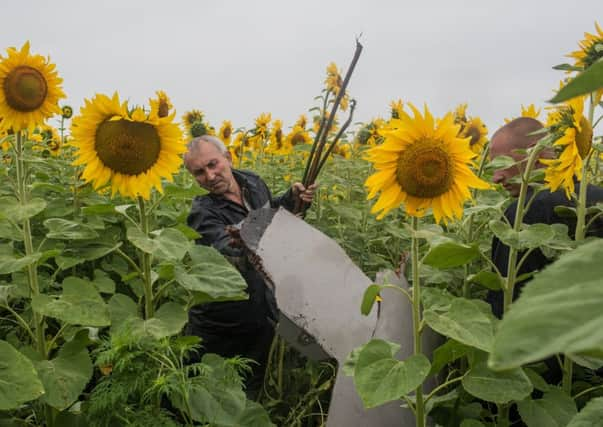MH17: First painful steps on road to finding truth


Rescue workers were already searching fields of wheat, marking bodies and body parts with long sticks topped with white ribbon to make collection easier, and by the middle of the day 181 bodies had been located.
Amid the burnt bodies, aircraft seats and luggage, guidebooks of Bali and Lombok could be seen, as could bags and t-shirts saying “I love Amsterdam’”.
Advertisement
Hide AdAdvertisement
Hide Ad“I went to a field, and to my right was the aircraft’s tail – if you can call it that now – and to my left the field was littered with white flags, each indicating a body or body part,” said Sergei Peshekhonov, who arrived on the scene as the rescue work got under way.
“The field was littered with flags. A lot of the corpses were just lying on the ground: many of them without clothes. Others were still strapped into their seats.
“The worst thing was that there were so many children. To see them dead was just awful.”
Around the area of the impact, human remains were covered in transparent plastic sheeting providing the dead only limited dignity. Graphic footage and photographs from the fields where the wreckage had been engulfed in an inferno of aviation fuel revealed that some of the bodies had been incinerated beyond recognition.
Arsen Avakov, Ukraine’s interior minister, announced that a team from Interpol would travel to Ukraine to assist in identifying the dead.
Along with human remains, the land was littered with the personal effects of the victims. Luggage, passports, mobile phones and children’s toys along with countless other items lay strewn across the fields.
Complicating the grim procedure of finding the dead is the problem of wreckage and bodies being scattered over a wide area, some of which lies in the no-man’s land of the war in eastern Ukraine.
Andrej Purgin, a member of the self-proclaimed “Donetsk People’s Republic”, which has been fighting government forces in the area, said it would be difficult to ensure the security of the crash site owing to the large spread of the wreckage.
Advertisement
Hide AdAdvertisement
Hide Ad“Apparently the plane broke up in the air so the wreckage of the Boeing and the bodies are scattered over 12 square kilometres,” he said. “Moreover, some of the wreckage fell in ‘neutral territory’ that has been the scene of intense fighting between the Ukrainian army and militias.”.
Despite the tragedy, fighting continued in areas near the crash site, and separatist rebels patrolled the roads leading to the remnants of MH17. Conscious of the fact that many already hold them responsible for the disaster, they denied any involvement and said they would not impede the investigation.
As the hunt for the dead continued, eyewitnesses have spoken of the moment it rained a debris of plane wreckage and human beings after the Boeing 777 exploded in mid-air on Thursday.
“There were two loud crashes and then the force of the blast made the windows shake,” one local resident told the Ukrainian press. “The plane broke into pieces and bits were scattered across my garden. I saw with my own eyes severed hands and feet.”
Another spoke of how a body crashed through her roof.
“There was a howling noise and everything started to rattle. Then objects started falling out of the sky,” said Irina Tipunova, a 65-year-old pensioner.
“And then I heard a roar and she landed in the kitchen, the roof was broken,” she said.
Igor Balut, governor of the Donetsk region, said the bodies will be sent to the city of Kharkiv while the investigation into the causes of the crash continues.
“We are working on taking the bodies from the crash site and getting in touch with relatives of the dead who want to come to Kharkiv,” he explained. “We’ve already booked around 600 accommodation places for the relatives of the victims.”
Advertisement
Hide AdAdvertisement
Hide AdHe added that the city has prepared volunteers with knowledge of English and French, as well as English-speaking psychologists.
“There is still no accurate information about when the first body will arrive in the city, as well as the first relatives,” he said.